General
News headlines that report crocodilian 'attacks' generate a 'need to read' in the public domain – and a spike in newspaper sales and online pageviews. However, in areas where people must coexist with crocodilians, the potential for negative interactions between crocodilians and local people, pets or livestock are a daily reality. This ongoing risk of attacks (or even the perception of a risk) and the resulting conflicts can have lethal consequences for both people and crocodilians (crocodiles, alligators and caiman, and gharials). The part fear/part fascination with such incidents is what we aim to address here, and offer some clarity on an often-sensationalised aspect of crocodilians and their interactions with humans.
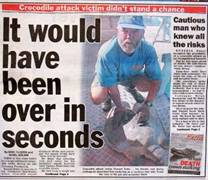 This page explores the facts about crocodilian attacks, whether fatal or non-fatal: what we can learn from the statistics, some limits to our knowledge, why crocodiles attack, how to avoid attacks, and we bust a few myths too. The issues surrounding what is termed Human-Crocodilian Conflict (HCC) – conflicts between humans over the appropriate responses to negative incidents and interactions with crocodilians, and the key components of successful crocodilian management – are dealt with on our HCC page.
This page explores the facts about crocodilian attacks, whether fatal or non-fatal: what we can learn from the statistics, some limits to our knowledge, why crocodiles attack, how to avoid attacks, and we bust a few myths too. The issues surrounding what is termed Human-Crocodilian Conflict (HCC) – conflicts between humans over the appropriate responses to negative incidents and interactions with crocodilians, and the key components of successful crocodilian management – are dealt with on our HCC page.
The word 'attack' kicks in a primal fear, regardless of the animal involved, and the possibility of being consumed heightens this fear considerably. We continue to use the word 'attack' because it is familiar, but note that it can be misinterpreted to suggest that crocodilian attacks are acts of random aggression or always involve feeding behaviour. We also distinguish between 'unprovoked' and 'provoked' attacks. Generally, 'provoked' attacks involve a person putting themselves in a situation that could clearly result in a crocodile biting or attacking them – whether the person is doing so knowingly or not. For example, deliberately approaching a wild crocodilian or trying to feed, touch, kill, annoy or catch the animal may provoke an attack. An 'unprovoked' attack implies that a person was either unaware of the presence of crocodilians, or was taking what could be considered due care in a crocodile area, and yet was subject to an attack.
Even 'unprovoked' attacks reflect natural behaviours. Crocodile attacks are not acts of random aggression, and can usually be avoided with knowledge and care when in crocodilian habitats (see below). Just because the trigger for an attack cannot always be identified does not mean the incident is therefore truly 'unprovoked'. Further, while at least 8 of the 26 recognised crocodilian species opportunistically prey on humans, most of the remainder pose little threat to humans.
The species involved
Of the 26 species of crocodilian currently recognised, 8 are known to regularly attack humans. Of these species, attacks by the saltwater crocodile (Crocodylus porosus), Nile crocodile (C. niloticus), American alligator (Alligator mississippiensis), mugger crocodile (C. palustris), the American crocodile (C. acutus) and black caiman (Melanosuchus niger) are best known. Morelet's crocodile (C. moreletii) and the spectacled caiman (Caiman crocodilus) also fairly regularly attack humans. Less commonly implicated are the West African crocodile (C. suchus), Tomistoma (Tomistoma schlegelii), and Australian freshwater crocodile (C. johnstoni). While other species, including the Siamese crocodile (C. siamensis), yacare caiman (Caiman yacare) and the Orinoco crocodile (C. intermedius) have been known to attack, few incidents are recorded (and <10 attacks each are recorded on CrocBITE for another 6 species). So while all crocodilians are capable of injuring humans, many very seldom do, and for a few of the smaller species, attacks are rarely more significant than a bite – often in defence. The paucity of records may be artefacts of the data in some cases: for example, there are few data implicating the New Guinea freshwater crocodile (C. novaeguineae) in attacks on humans.
The incidence of crocodilian attacks on humans in many countries is challenging to quantify. It is likely that many more people are attacked than is reported, as many attacks occur in remote areas. Fatal incidents are more likely to be reported than non-fatal ones. Accurate data collection does not usually occur until a species is legally protected and formal monitoring is introduced. For example, in northern Australia, records of saltwater crocodile attacks since 1971 (the year when the species was protected) are more complete and contain much more detail than many of the incidents prior to protection. An increase in reports of attacks by saltwater crocodiles in Papua New Guinea are thought to be partly due to better communication being available to people living in remote areas - namely mobile telephones! So apparent upward trends in attacks may also be artefacts of changes in data collection and reporting, and require careful investigation.
Why do crocodilians attack humans?
Here we summarise the main reasons why crocodilians attack humans. Reasons for 'unprovoked' attacks are considered to include:
Hunting for food: All crocodilians are opportunistic feeders, eating a wide range of prey. With increasing body size, most crocodilians shift to larger prey, and humans are well within the size range of prey that can be taken by the larger crocodilian species (gharials are an exception to this, remaining almost exclusively fish-eaters despite some reaching very large sizes).
Defence of territory: Some species, such as saltwater crocodiles, are highly territorial, and will defend their territory against intruders, including humans.
Defence of nest and/or young: All crocodilian species exhibit some form of nest defence in the wild and in captivity. Smaller species or populations in areas with human disturbance are often less likely to show such behaviour with humans in the wild, but still defend nests from other predators. Crocodilians will also respond to distress calls (vocalisations) made by their young and may attack humans near hatchlings. There are few recorded cases of attacks for these reasons – presumably because nest sites are often not easily accessible, and not too many people choose to disturb nests or hatchlings
Mistaken identity: It is possible that some attacks were directed at dogs or other domesticated animals accompanying people, with people either being injured/killed by mistake or when they try to intervene. Fishermen checking nets, discarding offal, or divers with fish attached to their dive belts may also be mistakenly attacked by crocodilians attracted to the fish.
Self-defence: like most wild animals, crocodilians will defend themselves if provoked. This may be unintentional, for example when a crocodilian is accidentally stepped on in murky water.
Safety tips to avoid being bitten
Crocodilians are opportunistic predators, learn from experience and have good memories, so it is not possible to predict how they will respond in all situations. Further, local conditions (e.g. food availability, seasonal changes in temperature and water levels, and human-crocodilian interactions) vary. Pay attention to warning signs and advice given by local experts and authorities in any region you are visiting where crocodilians are present.
- Crocodilians can move between different water bodies, (and often at night), so be careful near all rivers, streams, dams or pools (even small ones) within the distributional range of crocodilians. The absence of a crocodilian on one day does not always mean there is not one present the next day. Some crocodilians have been recorded travelling significant distances to very specific water bodies, timed to the day to coincide with fish migrations and therefore easy feeding.
- A large crocodilian can stay underwater for several hours, so do not assume one is not present, even if you have not seen one for a period of time.
- Crocodilians are camouflaged, and hunt with just their raised eyes, ears and nostrils exposed, and even large individuals can submerge in just 30 cm of water. As an ambush predator, they are designed to not be seen!
- Crocodilians often hunt near the water's edge, so be alert on the shore and in the shallows. A crocodilian can jump almost its entire body-length out of the water, and move rapidly overland for short distances. So, stay at least 5 m from the water where crocodilians are present.
- Never swim, dive or enter the water for any reason in areas where crocodilians are known to be present. You are not safe in deep water: crocodilians can bite whilst fully submerged.
- If you must enter the water, use Crocodile Excluding Enclosures if available and well maintained (check their condition before using them).
- Crocodilians are particularly active at night, so be extra careful around water after dark. Their senses are more adapted for the dark than are yours.
- Do not dangle legs, arms, heads or bottoms over the sides of boats, and minimise time in the water when launching or landing boats.
- If your fishing line or net gets entangled in the water, cut the line – your life is worth more than your fishing gear.
- In areas in which crocodilians are known to occur, camp at least 50 m from the shore and 2 m above the high-water mark.
- Do not prepare food, wash dishes, fillet fish or leave dead animals at the water's edge or around boat ramps and other access points, and do not feed wild crocodilians. Don't leave food or food waste exposed in campsites in crocodilian habitat. They will scavenge food some distance from the water.
- Do not ignore warning signs and keep pets and small children out of the water (they are an optimum size for being attacked – and they cannot read).
- In some regions, attacks are seasonal – although they may still occur all year around – so check the details for the region you are in/visiting and be extra careful near water in dangerous periods.
- Stay at least 10 m from wild crocodilians and never provoke them – it is very dangerous, and they can move extremely quickly when provoked. If you in a boat and approach basking crocodiles, they will invariably flee into the water and won't stop if you are in the way. Report aggressive crocodilians to the local conservation authority if there is one.
- Do not try to catch small crocodilians (e.g. hatchlings), or remove eggs from their nests; their mothers or other adults may be nearby, and the distress calls of hatchlings may attract them.
CrocBite Data
Data is collected on crocodilian attacks to look for patterns in the data that can help us improve safety advice. Some of this is general (see above), but in many cases the data tells us about the circumstances in particular places - eg what times of year most attacks occur, what people are doing at the time, where, etc. CSG members and some conservation authorities collect data on crocodilians involved, on factors affecting crocodile behaviour such as water levels and temperatures, and on the victims. Most data are submitted to CrocBITE, and the standardised categories of data used are available in a spreadsheet for reporting attacks - freely downloadable from the CrocBITE website. Data has been analysed for some regions where attacks are a consistent problem (see Pooley (2024) for a comprehensive list).
There are of course limitations to these data, and it is important to remember that we count only reported, verified attacks by wild crocodilians (and not if they are being handled for management or research purposes). Some incidents may go unreported, especially in remote rural areas, and some reported attacks are not actually crocodilian attacks or may have occurred post-mortem due to scavenging on drowned persons or animals.
Some Statistics
The most comprehensive datasets on attacks are available for the saltwater crocodile in Australia (C. porosus), Nile crocodile (C. niloticus) in South Africa, and the American alligator (A. mississippiensis) in the USA. A small sample of the available data on attacks by these species have been summarised in Table 1 and figures 1-4 to illustrate a few kinds of data that are collected. When summarising species data, especially for those with large distributions and where local conditions and interactions vary, only a few variables will remain constant.
Table 1: CrocBITE data for total attacks by species for the
period 2010-20. Column 2 specifies the number of countries the database
has records for attacks from within this period. The lengths refer to
the size range attained by large adult males. Rare individuals may
surpass the maximum lengths shown.
|
Species
|
No. of countries
|
Large adult size
|
Fatal
|
Non-fatal
|
Total
|
|
Crocodylus porosus
|
13
|
4.5-5.5m
|
668
|
682
|
1350
|
|
Crocodylus niloticus
|
20
|
4-5m
|
696
|
309
|
1005
|
|
Crocodylus palustris
|
5
|
3.5-4m
|
171
|
252
|
429
|
|
Crocodylus acutus
|
12
|
4-4.5m
|
26
|
159
|
185
|
|
Alligator mississippiensis
|
6
|
4-4.5m
|
6
|
121
|
127
|
|
Crocodylus moreletii
|
3
|
3m
|
9
|
64
|
73
|
|
Melanosuchus niger
|
6
|
4-4.5m
|
18
|
51
|
69
|
|
Caiman crocodilus
|
5
|
1.8-2.2m
|
1
|
30
|
31
|
|
Tomistoma
schlegelii
|
1
|
4.5-5m
|
10
|
18
|
28
|
|
Crocodylus
suchus
|
5
|
3.5-4.5m
|
8
|
4
|
12
|
|
Crocodylus
johnstoni
|
1
|
2.5-3m
|
0
|
16
|
16
|
Figure 1: CrocBITE data showing trends in recorded attacks by the
seven species of crocodilian responsible for most reported attacks over
the period 2010-19.
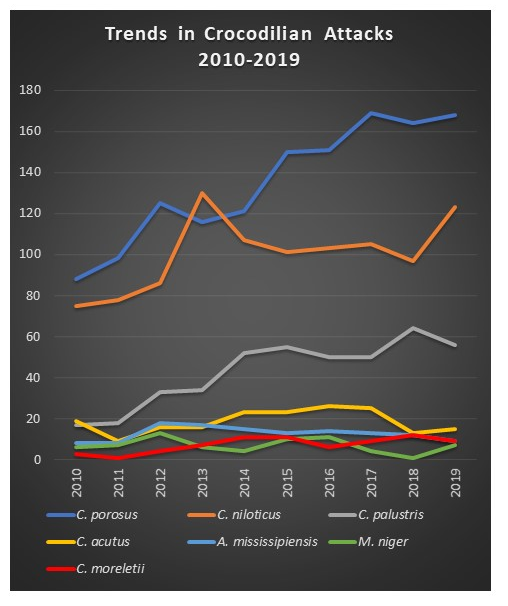
Reporting is variable, and in some cases the marked increases (e.g. Crocodylus porosus and C. palustris) may be an artefact of improved reporting. The relative proportion of attacks is likely accurate. Most C. porosus data here is from Indonesia and Malaysia, but (unreported) attacks occur in Papua New Guinea and the Solomon Islands, for example. The erratic C. niloticus trend may show variability in attack incidence, but probably illustrates that reporting is very patchy for many countries in its extensive range in Africa. It is similarly challenging to assess trend data for C. acutus, which is also widely distributed across Latin America and the Caribbean.
We see some expected as well as some interesting trends when we look at the proportion of fatal to nonfatal attacks by each species. Larger crocodilians (e.g. C. porosus, C. niloticus and T. schlegelii) are expected to be responsible for a higher proportion of fatal attacks and the data supports this. Recovering species such as C. acutus (figure 2) have fewer individuals at larger sizes for that species, and therefore fewer fatal attacks when compared to their overall attack data. Size isn't everything, though: A. mississippiensis is responsible for a low proportion of fatalities when compared to C niloticus, for example.
Figure 2: Fatal and non-fatal attacks on humans by C. acutus (2010-20).
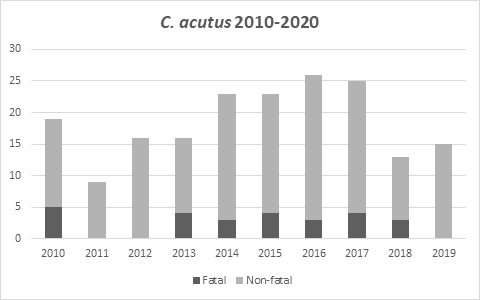
There is also variability with species, with C. niloticus (figure 3) apparently responsible for the highest proportion of fatal/non-fatal attacks, where A. mississippiensis (figure 4) is responsible for a low proportion of fatalities.
Figure 3: Fatal and non-fatal attacks on humans by C. niloticus (2010-20).
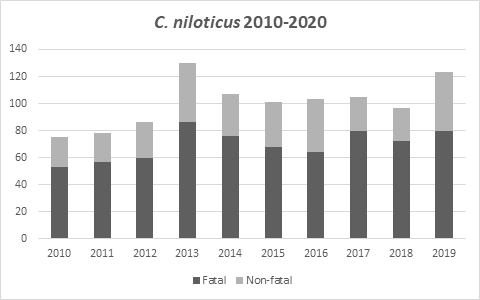
Figure 4: Fatal and non-fatal attacks on humans by A. mississippiensis (2010-20).
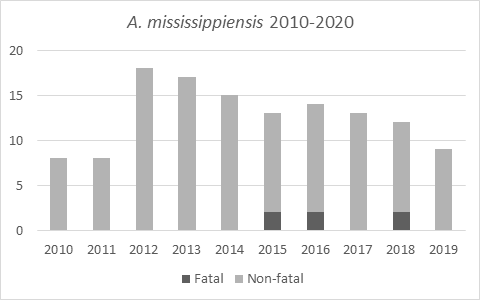
Busting some Myths about Crocodile Attacks
Mass attack on Ramree Island?
The worst “mass attack” by crocodiles allegedly occurred during World War II on the night of 19 February 1945, when approximately 1000 Japanese soldiers found themselves pinned down in a mangrove swamp separating Ramree Island from the mainland of Myanmar (then Burma). Only 20 Japanese soldiers allegedly escaped alive from the saltwater crocodiles in the swamp. Although this story is widely shared in the media, Platt et al. (2001) showed that while nearly 1000 Japanese soldiers likely did die during the invasion of the island by a combined British and Indian force, this was likely the result of injuries resulting from armed combat, disease, starvation and suicide (rather than surrender), with few deaths attributable to crocodiles.
Crocodiles cannot bite underwater
Not true! They have a palatal valve that seals off the back of the mouth/throat, preventing water entering the lungs when underwater. They are therefore quite capable of biting and holding onto prey underwater.
Crocodilians are best evaded on land by running in zigzag fashion
Not true – though if you advise your companions to do so, this may give you a head-start! However, crocodilians in predatory-mode can emerge from the water extremely fast and without warning. Their legs and momentum will often see them cover short distances on land very quickly. So, forget the zig-zag nonsense and just stay well away from the water's edge. In thicker, muddy substrates, even large crocodilians can move faster than you!
“Maneaters”
The media loves stories about “maneaters” but seldom define what it means. There are no rules on this, but it seems self-evident that an animal classified in this way should have hunted, caught and eaten several humans, ie to appear to be making a habit of it. Arguably, for large crocodilians that eat large prey regularly, humans are just another prey item. That said, some individual crocodiles appear to have learned to hunt people in places where they repeatedly perform certain activities like washing, swimming or crossing.
There is no evidence to suggest that old crocodilians that can no longer catch their 'natural' prey take to hunting humans. Some zoos advertise large crocodiles as captured man-eaters – often this is more from the marketing department than reality.
Recommended Reading
For a reasonably comprehensive list of the published literature, see: Pooley, S. (2024). Croc Digest: A bibliography of human-crocodile conflict research and reports, 5th ed. Simon Pooley: London).
See also the Human-Crocodile Conflict page on this website
Online resources
Florida Fish and Wildlife Service Commission. Living with crocodiles and alligators. Includes a variety of resources, available here https://myfwc.com/conservation/you-conserve/wildlife/gators/https://myfwc.com/conservation/you-conserve/wildlife/gators/
Northern Territory Government, be Crocwise resources available at:
https://nt.gov.au/emergency/community-safety/crocodile-safety-be-crocwise
Queensland Department of Environment and Science crocodile safety videos, available at:
https://www.youtube.com/user/QldEHP/search?query=crocodiles
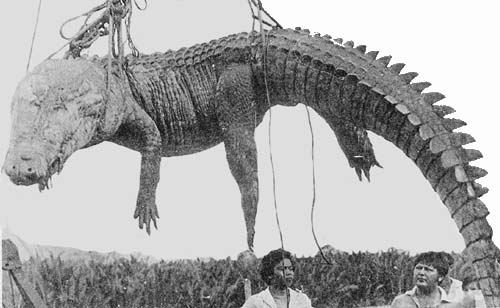


 Email CSG
Email CSG This page explores the facts about crocodilian attacks, whether fatal or non-fatal: what we can learn from the statistics, some limits to our knowledge, why crocodiles attack, how to avoid attacks, and we bust a few myths too. The issues surrounding what is termed Human-Crocodilian Conflict (HCC) – conflicts between humans over the appropriate responses to negative incidents and interactions with crocodilians, and the key components of successful crocodilian management – are dealt with on our
This page explores the facts about crocodilian attacks, whether fatal or non-fatal: what we can learn from the statistics, some limits to our knowledge, why crocodiles attack, how to avoid attacks, and we bust a few myths too. The issues surrounding what is termed Human-Crocodilian Conflict (HCC) – conflicts between humans over the appropriate responses to negative incidents and interactions with crocodilians, and the key components of successful crocodilian management – are dealt with on our 



